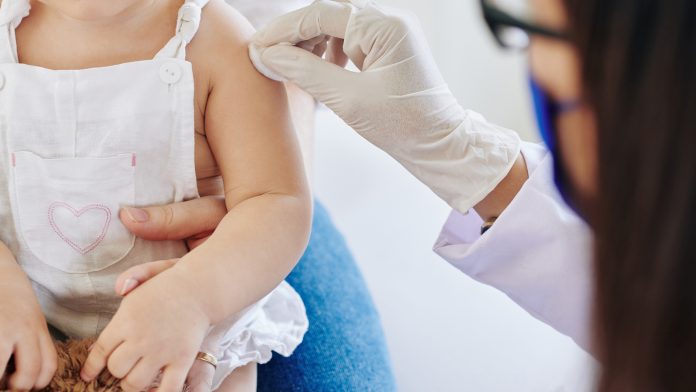
Official data from WHO and UNICEF finds the largest sustained decline in childhood vaccinations in around 30 years.
In the UK, children up to 15 years old can have several vaccines to protect them from infections and diseases, including the HPV vaccine, Rotavirus vaccine and Flu vaccine. Despite their lifesaving qualities, childhood vaccination uptake is decreasing significantly.
The percentage of children who received three doses of the vaccine against diphtheria, tetanus, and pertussis (DTP3) – a marker for vaccine coverage within and across countries – fell by five percentage points between 2019 and 2021 to 81%.
25 million children missing vital vaccinations
The concerning data revealed that 25 million children did not receive one or more doses of DTP through routine immunisation services in 2021. This is two million more than data recorded in 2020 and six million more than in 2019, indicating a sheer drop in childhood vaccinations.
The decline was a result of several factors. An increased number of children living in conflict, COVID-19 causing disruptions, resource diversion to response efforts and containment measures that limited immunisation service and availability were all causes for concern.
“This is a red alert for child health. We are witnessing the largest sustained drop in childhood immunisation in a generation. The consequences will be measured in lives,” said Catherine Russell, UNICEF Executive Director. “While a pandemic hangover was expected last year as a result of COVID-19 disruptions and lockdowns, what we are seeing now is a continued decline. COVID-19 is not an excuse. We need immunisation catch-ups for the missing millions or we will inevitably witness more outbreaks, more sick children and greater pressure on already strained health systems.”
Furthermore, the coverage achieved in 2019 for HPV vaccines decreased in 2021, with over one-quarter fewer vaccines delivered that year. Severe consequences for women and girls can arise with global coverage of the first HPV vaccine being 15%.
The World Health Organization (WHO) and UNICEF understood that 2021 would focus on recovering the strained childhood vaccination programmes. However, DTP3 coverage has reduced to its lowest level since 2008, making global goals less attainable. Additionally, falling childhood vaccination rates are simultaneous with growing numbers of severe acute malnutrition in children. Malnourished children have weakened immunity, and missing vital vaccinations can lead to life-threatening circumstances.
“Planning and tackling COVID-19 should also go hand-in-hand with vaccinating for killer diseases like measles, pneumonia and diarrhoea,” said Dr Tedros Adhanom Ghebreyesus, WHO Director-General. “It’s not a question of either/or, it’s possible to do both”.
Steps to improve childhood vaccination rates
WHO and UNICEF are working with Gavi, the Vaccine Alliance and other partners to deliver the global Immunisation Agenda 2030 (IA2030), a strategy set for all countries to deliver vaccination goals to prevent deadly diseases and infections.
The IA2030 partners have outlined key steps to improve childhood vaccination rates globally and are calling upon governments to take action:
- Increase efforts to catch up on childhood vaccinations to address the decrease in uptake and improve service availability to vulnerable areas.
- Implement strategies that build trust in vaccines and immunisation, challenge misinformation and increase vaccine uptake.
- Develop pandemic preparedness and response strategies and ensure global healthcare is strengthened with investment.
- Ensure political commitment from national governments and increase domestic resource allocation to strengthen childhood vaccination efforts within primary healthcare.
- Prioritise health information and disease surveillance systems to provide accurate data.
- Leverage and increase investment in research to develop and improve new and existing vaccines and immunisation services that will deliver IA2030 goals.

























